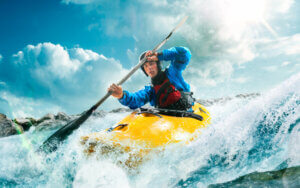The 4 Most Common Kayaking Injuries

The most common kayaking injuries affect the muscles and the bones, and they can keep you out of action for a long time.
Kayaking involves moving a boat, known as a kayak, across the water using a paddle. The paddle has two blades, one on either end, which is used to propel the kayak through the water.
Although there are differences between kayaking and canoeing, colloquially, people use the terms interchangeably. But, whether participating as a professional or an amateur, the different weights between boats can have a significant influence on the type of injuries you could suffer.
The upper body is the most important part of this sport, with a particular effort made by the back and the arms. The abdomen also plays an important role in balance and propulsion mechanics.
Based on the experience of kayakers over the years, the most common kayaking injuries are caused by overdoing it. Long distances, poor physical preparation, adverse weather conditions, and changes to the boat are all enough to cause damage to the body.
The four most common kayaking injuries
Since the upper body is the part doing most of the work in kayaking, the most four most common injuries occur between the hips and the hands. They consist of inflammation in the tendons, potential stress fractures, build-ups of synovial fluid, and lower back pain.
Tenosynovitis of the wrist
The extensor tendons of the wrist are used a lot in kayaking so it’s somewhat expected that they’ll become inflamed. This especially happens when kayaking in cold or icy waters.
Once the tendons become inflamed, the area will begin to hurt and swell up. You may notice that your wrist is larger than usual and it may also turn light red. Some patients may notice a popping sound when pressing on the wrist area.

To treat this injury, the patient will require a splint. This will keep the wrist immobile until the inflammation has disappeared. It may also be a good idea to take some anti-inflammatory medication.
If you often go kayaking in cold climates, it’s really important to wear plenty of thermal clothing on your arms and hands, such as additional thermal sleeves and gloves.
Rib stress fractures
Kayakers often fracture their ribs even without receiving a trauma. This is because of the stress caused by the repetitive movement involved in kayaking.
Up to almost 10 percent of the most common kayaking injuries involve the ribs, located towards the back of the rib cage.
The most obvious symptom of this injury is pain. However, some athletes have a high pain threshold and only notice it after it has gotten considerably worse. This can lead to late diagnosis and complicate the healing process.
Another problem with rib injuries similar to this is that they don’t always show up clearly on an x-ray. This means that a more complex examination, such as tomography, might be necessary instead.
Ischial bursitis
The joints in the body have bags of fluid that help control mobility and prevent friction between the bones. When kayaking, a lot of weight is exerted on the hips for long periods of time.
As a result, the bags (or bursa) in the hamstrings can become inflamed near the buttocks. This causes pain in the coccyx area, known as coccydynia.

The symptoms are tingling, pain, and electrical sensations in the buttocks and the upper leg. If it gets worse, it can become difficult to sit in the boat.
To avoid this injury, the ergonomics of the kayak are very important, and the seat may need modifications. Keeping the skin dry is also essential, so proper hygiene at the end of an excursion is key.
Lower back pain
Back pain is a very common kayaking injury because of the posture involved. Sitting in the kayak for long hours can affect the spinal column and lead to inflammation.
It doesn’t always lead to herniated discs, but it’s important to be careful to prevent this from happening. Ideally, you shouldn’t force your back to do anything if you feel any initial pain. In such circumstances, it’s important to let the muscles relax.
The symptoms are the same as with other forms of lower back pain, with the pain radiating to the legs, as well as difficulty walking or urinating. Treatment involves plenty of rest, anti-inflammatories, and the use of a lumbar girdle.
Prevent kayaking injuries before they appear
If you’re a kayaking enthusiast, it’s important to take care of your body so that you can enjoy practicing the sport as long as possible. Good training on and off the boat, as well as paying close attention to any warning signs, are all an essential part of looking after your health.
Don’t hesitate to consult a doctor if you start to feel any pain in the back, chest, or upper limbs. The sooner you receive treatment, the less risk of a serious and prolonged injury.
The most common kayaking injuries affect the muscles and the bones, and they can keep you out of action for a long time.
Kayaking involves moving a boat, known as a kayak, across the water using a paddle. The paddle has two blades, one on either end, which is used to propel the kayak through the water.
Although there are differences between kayaking and canoeing, colloquially, people use the terms interchangeably. But, whether participating as a professional or an amateur, the different weights between boats can have a significant influence on the type of injuries you could suffer.
The upper body is the most important part of this sport, with a particular effort made by the back and the arms. The abdomen also plays an important role in balance and propulsion mechanics.
Based on the experience of kayakers over the years, the most common kayaking injuries are caused by overdoing it. Long distances, poor physical preparation, adverse weather conditions, and changes to the boat are all enough to cause damage to the body.
The four most common kayaking injuries
Since the upper body is the part doing most of the work in kayaking, the most four most common injuries occur between the hips and the hands. They consist of inflammation in the tendons, potential stress fractures, build-ups of synovial fluid, and lower back pain.
Tenosynovitis of the wrist
The extensor tendons of the wrist are used a lot in kayaking so it’s somewhat expected that they’ll become inflamed. This especially happens when kayaking in cold or icy waters.
Once the tendons become inflamed, the area will begin to hurt and swell up. You may notice that your wrist is larger than usual and it may also turn light red. Some patients may notice a popping sound when pressing on the wrist area.

To treat this injury, the patient will require a splint. This will keep the wrist immobile until the inflammation has disappeared. It may also be a good idea to take some anti-inflammatory medication.
If you often go kayaking in cold climates, it’s really important to wear plenty of thermal clothing on your arms and hands, such as additional thermal sleeves and gloves.
Rib stress fractures
Kayakers often fracture their ribs even without receiving a trauma. This is because of the stress caused by the repetitive movement involved in kayaking.
Up to almost 10 percent of the most common kayaking injuries involve the ribs, located towards the back of the rib cage.
The most obvious symptom of this injury is pain. However, some athletes have a high pain threshold and only notice it after it has gotten considerably worse. This can lead to late diagnosis and complicate the healing process.
Another problem with rib injuries similar to this is that they don’t always show up clearly on an x-ray. This means that a more complex examination, such as tomography, might be necessary instead.
Ischial bursitis
The joints in the body have bags of fluid that help control mobility and prevent friction between the bones. When kayaking, a lot of weight is exerted on the hips for long periods of time.
As a result, the bags (or bursa) in the hamstrings can become inflamed near the buttocks. This causes pain in the coccyx area, known as coccydynia.

The symptoms are tingling, pain, and electrical sensations in the buttocks and the upper leg. If it gets worse, it can become difficult to sit in the boat.
To avoid this injury, the ergonomics of the kayak are very important, and the seat may need modifications. Keeping the skin dry is also essential, so proper hygiene at the end of an excursion is key.
Lower back pain
Back pain is a very common kayaking injury because of the posture involved. Sitting in the kayak for long hours can affect the spinal column and lead to inflammation.
It doesn’t always lead to herniated discs, but it’s important to be careful to prevent this from happening. Ideally, you shouldn’t force your back to do anything if you feel any initial pain. In such circumstances, it’s important to let the muscles relax.
The symptoms are the same as with other forms of lower back pain, with the pain radiating to the legs, as well as difficulty walking or urinating. Treatment involves plenty of rest, anti-inflammatories, and the use of a lumbar girdle.
Prevent kayaking injuries before they appear
If you’re a kayaking enthusiast, it’s important to take care of your body so that you can enjoy practicing the sport as long as possible. Good training on and off the boat, as well as paying close attention to any warning signs, are all an essential part of looking after your health.
Don’t hesitate to consult a doctor if you start to feel any pain in the back, chest, or upper limbs. The sooner you receive treatment, the less risk of a serious and prolonged injury.
All cited sources were thoroughly reviewed by our team to ensure their quality, reliability, currency, and validity. The bibliography of this article was considered reliable and of academic or scientific accuracy.
- López, C. López, and J. Ribas Serna. Análisis biomecánico de la articulación de la muñeca en el paleo en kayak: modelo dinámico. Revista Andaluza de Medicina del Deporte 2.3 (2009): 102-107.
- Macancela Bucaram, Olfa Martha. Lesiones deportivas en los atletas de canotaje, guia de prevención. Diss. Universidad de Guayaquil. Facultad de Ciencias Médicas. Escuela de Graduados, 2016.
- Ocampo Chacón, Ronald. El paciente deportista con lesión en la región de la cadera: abordaje radiológico. (2017).
- Monserrat, Rigo, and Andreu Jaume. ¿ Las mujeres deportistas que sufren fracturas por estrés están diagnosticadas de tríada de la mujer deportista?. (2018).
- Fariña Rivera, Francisca, et al. Estilos de afrontamiento y recuperación de las lesiones deportivas en kayakistas de élite. Revista de psicologia del Deporte 25.1 (2016): 0043-50.
- Vázquez Franco, Mirella. Composición corporal de piragüistas de alto rendimiento a lo largo de la temporada deportiva. (2018).
This text is provided for informational purposes only and does not replace consultation with a professional. If in doubt, consult your specialist.








